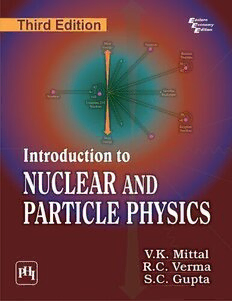Table Of ContentIntroduction to
Nuclear and Particle Physics
Third Edition
V.K. MITTAL
Professor of Physics
Punjabi University, Patiala
R.C. VERMA
Professor of Physics
Punjabi University, Patiala
S.C. GUPTA
Former Professor and Head
Department of Physics
Punjabi University, Patiala
Delhi-110092
2013
.
INTRODUCTION TO NUCLEAR AND PARTICLE PHYSICS, Third Edition
V.K. Mittal, R.C. Verma and S.C. Gupta
© 2013 by PHI Learning Private Limited, Delhi. All rights reserved. No part of this book may be
reproduced in any form, by mimeograph or any other means, without permission in writing from the
publisher.
ISBN-978-81-203-4738-0
The export rights of this book are vested solely with the publisher.
Third Printing (Third Edition) … … … April, 2013
Published by Asoke K. Ghosh, PHI Learning Private Limited, Rimjhim House, 111, Patparganj
Industrial Estate, Delhi-110092 and Printed by Raj Press, New Delhi-110012.
.
Contents
Preface…xiii
Preface to the First Edition…xv
1. The Nucleus…17–45
1.1 Introduction……1
1.2 Historical Developments……1
1.3 Constituents of the Nucleus……3
1.3.1 Proton–Electron Hypothesis……3
1.3.2 Proton–Neutron Hypothesis……5
1.3.3 Terms Associated with the Nucleus……7
1.4 Quantitative Facts about Nucleus……8
1.4.1 Size……8
1.4.2 Mass……9
1.4.3 Density……10
1.4.4 Energy……11
1.4.5 Charge……12
1.5 Binding Energy……12
1.5.1 Mass Defect……12
1.5.2 Packing Fraction……13
1.5.3 Fusion and Fission……14
1.5.4 Binding Energy per Nucleon……14
1.6 Nuclear Angular Momentum……16
1.7 Nuclear Moments……18
1.7.1 Magnetic Dipole Moment……18
1.7.2 Electric Quadrupole Moment……20
1.8 Wave Mechanical Properties……22
1.8.1 Parity……23
1.8.2 Statistics……23
1.9 Nature of Nuclear Forces……24
1.10 Yukawa Theory of Nuclear Forces……26
1.11 Mass Spectrometry……27
1.11.1 Bainbridge Spectrograph……28
1.11.2 Bainbridge and Jordan Mass Spectrograph……30
1.12 Determination of Charge by Moseley Law……31
Numerical Problems……32
Review Questions……43
2. Nuclear Models…46–78
2.1 Introduction……46
2.2 Liquid Drop Model……47
2.2.1 Semiempirical Mass Formula……47
2.2.2 Mass of Most Stable Isobar……51
2.2.3 Achievements of Liquid Drop Model……52
2.2.4 Failures of Liquid Drop Model……52
2.3 Shell Model……52
2.3.1 The Square Well Potential……56
2.3.2 The Harmonic Oscillator Potential……59
2.3.3 Spin-Orbit Coupling……61
2.3.4 Predictions of the Shell Model……62
2.3.5 Achievements of the Shell Model……64
2.3.6 Failures of Shell Model……65
*2.4 Fermi Gas Model……65
2.5 Collective Model……67
Numerical Problems……67
Review Questions……76
3. Radioactivity…79–153
3.1 Introduction……79
3.2 Laws of Disintegration……81
3.2.1 Activity and its Units……82
3.2.2 Half-life……83
3.2.3 Average (Mean) Life……84
3.3 Radioactive Series……85
3.4 Law of Successive Disintegration……87
3.4.1 Radioactive Equilibrium……90
3.5 Alpha Emission……94
3.5.1 Properties of Alpha Particles……96
3.5.2 Alpha Spectrum……96
3.5.3 Range of Alpha-Particles……98
3.5.4 Geiger–Nuttal Law……98
3.5.5 Gamow Theory of Alpha Decay……99
3.6 Beta Decay……107
–
3.6.1 Conditions for Spontaneous Emission of (cid:0) -Particles……107
+
3.6.2 Conditions for Spontaneous Emission of (cid:0) -Particles……108
3.6.3 Beta-Particle Spectrum……109
3.6.4 Electron Capture……112
3.6.5 Neutrino ((cid:0)) and Antineutrino ( )……112
3.6.6 Detection of Antineutrino ( )……112
3.6.7 Detection of Neutrino ((cid:0))……113
3.7 Gamma Decay……114
3.7.1 Gamma Decay……114
3.7.2 Internal Conversion……115
3.7.3 Internal Pair Conversion……116
3.8 Artificial or Induced Radioactivity……118
* 3.9 Applications of Radioactivity……119
3.9.1 Medicine……120
3.9.2 Food and Agriculture……120
3.9.3 Insect Control……120
3.9.4 Reactors……121
3.9.5 Research Reactors……122
3.9.6 Geology and Element Identification……123
3.9.7 Radioactive Dating……123
3.9.8 Radioactive Tracers……125
3.9.9 Neutron Activation Analysis (NAA)……126
3.9.10 In Space Flights……126
3.9.11 In Sea……127
Numerical Problems……127
Review Questions……150
4. Nuclear Reactions…154–202
4.1 Introduction……154
4.2 Types of Nuclear Reactions……156
4.2.1 Reactions Based on the Reaction Mechanism……156
4.2.2 Reactions Based on the Mass of Projectile……158
4.3 Nuclear Reaction Cross-Section……163
4.3.1 Measurement of Cross-Section……163
4.3.2 Units of Cross-Section……164
4.3.3 Different Types of Cross-Sections……165
4.4 Conservation Laws in Nuclear Reactions……165
4.4.1 Conservation of Mass-Energy……166
4.4.2 Conservation of Linear Momentum……166
4.4.3 Conservation of Charge/Atomic Number……166
4.4.4 Conservation of Nucleons/Mass Number……166
4.4.5 Conservation of Angular Momentum……167
4.4.6 Conservation of Spin……167
4.4.7 Conservation of Statistics……167
4.4.8 Conservation of Parity……167
4.4.9 Conservation of Lepton Number……167
4.5 Kinematics of Nuclear Reactions……168
4.5.1 Exoergic or Exothermic Reactions……170
4.5.2 Endoergic or Endothermic Reactions……171
4.5.3 Threshold Energy……171
4.6 Compound Nucleus……172
* 4.7 Nuclear Fission……173
4.7.1 Neutron-Induced Fission……173
4.7.2 Energy Released in Fission……175
* 4.8 Nuclear Fusion……176
4.8.1 Energy Released in Fusion……177
4.8.2 Hydrogen Burning and Solar Energy……178
4.8.3 Helium Burning in Stars……179
Numerical Problems……180
Review Questions……201
5. Interaction of Radiations with Matter…203–241
5.1 Introduction……203
5.2 Energy Loss by Heavy Charged Particles……203
5.3 Interaction of Electrons with Matter……208
5.4 Range of Charged Particles……210
5.5 Interaction of Gamma Rays with Matter……211
5.5.1 Radiation Length……213
5.5.2 Half-thickness……213
5.5.3 Experimental Determination of Attenuation Coefficient……213
5.6 Photoelectric Effect……215
5.6.1 Experimental Verification of Photoelectric Effect……217
5.7 Compton Effect……219
5.7.1 Experimental Verification of Compton Effect……222
5.8 Pair Production……224
5.8.1 Positron Annihilation……225
Numerical Problems……226
Review Questions……239
6. Particle Accelerators…242–282
6.1 Introduction……242
6.2 Cockcroft and Walton Accelerator……243
6.2.1 Principle……243
6.2.2 Construction……243
6.2.3 Working……244
6.2.4 Advantages……244
6.2.5 Limitations……244
6.3 Van de Graaff Accelerator……245
6.3.1 Principle……245
6.3.2 Construction……245
6.3.3 Working……246
6.3.4 Advantages……246
6.3.5 Limitations……247
6.4 Tandem Accelerator……247
6.4.1 Principle……247
6.4.2 Construction and Working……247
6.4.3 Advantages……248
6.4.4 Limitations……248
6.5 Linear Accelerator (LINAC) or Drift Tube Accelerator……249
6.5.1 Principle……249
6.5.2 Construction……249
6.5.3 Working……250
6.5.4 Advantages……251
6.5.5 Limitations……252
6.6 Wave-Guide Accelerators……252
6.7 Magnetic Resonance Accelerators or Cyclotrons……252
6.7.1 Principle……253
6.7.2 Construction……253
6.7.3 Working……254
6.7.4 Theory……254
6.7.5 Advantages……256
6.7.6 Limitations……256
6.8 Betatron……257
6.8.1 Principle……257
6.8.2 Construction……257
6.8.3 Working……258
6.8.4 Average Energy per Orbit……259
6.8.5 Calculation of Final Energy of Electrons……259
* 6.9 Synchrocyclotrons or Frequency Modulated Cyclotrons……261
6.9.1 Principle……261
6.9.2 Construction……261
6.9.3 Theory……262
6.9.4 Advantages……263
6.9.5 Limitation……263
* 6.10 Azimuthally Varying Field (A.V.F.) or Sector Focusing
Cyclotrons……263
6.10.1 Principle……263
6.10.2 Construction……264
6.11 Synchrotrons……265
6.11.1 Proton Synchrotron……265
Numerical Problems……268
Review Questions……282
7. Radiation Detectors…283–325
7.1 Introduction……283
7.2 Gas-Filled Detectors……284
7.2.1 Principle……285
7.2.2 Construction and Working……285
7.2.3 Concept of Average Energy Required for Creating Electron–Ion
Pair (W-value)……285
7.3 Ionization Chamber……288
7.3.1 Principle……288
7.3.2 Construction……288
7.3.3 Working……289
7.3.4 Main Uses……289
7.3.5 Main Drawback……289
7.4 Proportional Counters……289
7.4.1 Principle……290
7.4.2 Construction……290
7.4.3 Working……290
7.4.4 Uses……292
7.4.5 Main Disadvantage……292
7.5 Geiger–Müller (GM) Counters……292
7.5.1 Principle……293
7.5.2 Construction……293
7.5.3 Working……293
7.5.4 Main Uses……296
7.5.5 Main Drawback……296
7.6 Scintillation Detectors……297
7.6.1 Scintillation Detector/Crystal……297
7.6.2 Photomultiplier Tubes……299
7.6.3 Electronic Circuitry……300
7.6.4 Uses of Scintillation Detectors……301
7.6.5 Limitations of Scintillation Detectors……301
7.7 Semiconductor Radiation Detectors……301
7.7.1 Diffused Junction Detector……303
7.7.2 Silicon Surface Barrier Detectors……304
7.7.3 Ion Implantation Detectors……304

